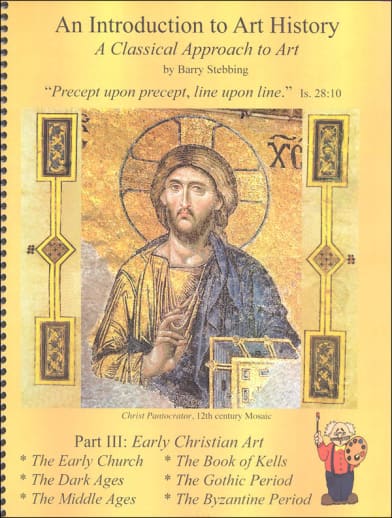We begin with the Roman Empire and making a mosaic and still life. Learn about the ancient Jews and the dispersion of Jews beyond Israel, aqueducts, Basilicas, and religious symbols. Continue on to Charlemagne, the Book of Kells, Gospels, and the Crusades, all with a corresponding assignment. ~Sara
Classical Approach to Art History Course III Early Christian Art
Description
Early Christian Art: This one yr. course discusses the symbols of early Christian art all the way to the end of the Gothic Period in the 14th century. It is divided into 3 parts, 12 lessons in each along with daily art lessons pertaining to what is being studied. Part I: The Early Church & The Dark Ages; Part II: The Middle Ages, Charlemagne & The Book of Kells; Part III: The Romanesque and The Gothic Periods. The course also discusses the influence of ancient Greek classical art within these eras.
If you have more than one student using the program, purchase this extra set of 18 (lesson & masterpieces) cardstock cards to accompany the printed version of An Introduction to Art History: Early Christian Art.
Subtitled A Classical Approach to Art, this series, directed to elementary and middle school students, pulls content from Barry Stebbing's four-year God and the History of Art course; reordering into different segments and adjusting lessons for a younger audience. Instruction is both classical and godly, and its user-friendly format will convince you that "I can do this." Courses are called Parts, which are each a full year's instruction in art history, art appreciation, and art projects. These can be done in any order allowing for coordination with other subjects and would be easy to adapt to a group or co-op setting. We currently have Parts I, II, and IV, expecting more by the end of the year. Courses include a Teacher's Guide with 36 detailed but brief lessons and quizzes plus sets of art lesson cards, and art masterpieces which are three-hole punched. You will need one set of these cards for each student. Art supplies, surprisingly few and simple, are the same for each course.
Lessons, found in the spiral-bound Teacher's Guide, include background information, examination of art time-periods or specific artists plus specific techniques. These lessons refer to the Masterpieces cards which are full-color reproductions of classic art pieces. The Art Lesson Cards provide the art project instruction that parallels the history and appreciation portion of the lessons as well as the space for completing those art projects. These are heavy-weight cardstock suitable for many types of art media. ~ Janice
Required art supplies:
- Set of 12 colored pencils
- Set of 8 water-soluble markers
- Medium nib black drawing pen
- #6 round brush
- Three-ring binder
| Product Format: | Other |
|---|---|
| Grades: | 1-8 |
| Brand: | How Great Thou Art |
| Author: | Barry Stebbing |
| Length in Inches: | 11.5 |
| Width in Inches: | 10.25 |
| Height in Inches: | 1.625 |
| Weight in Pounds: | 0.875 |

